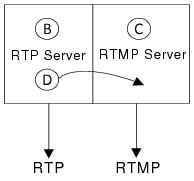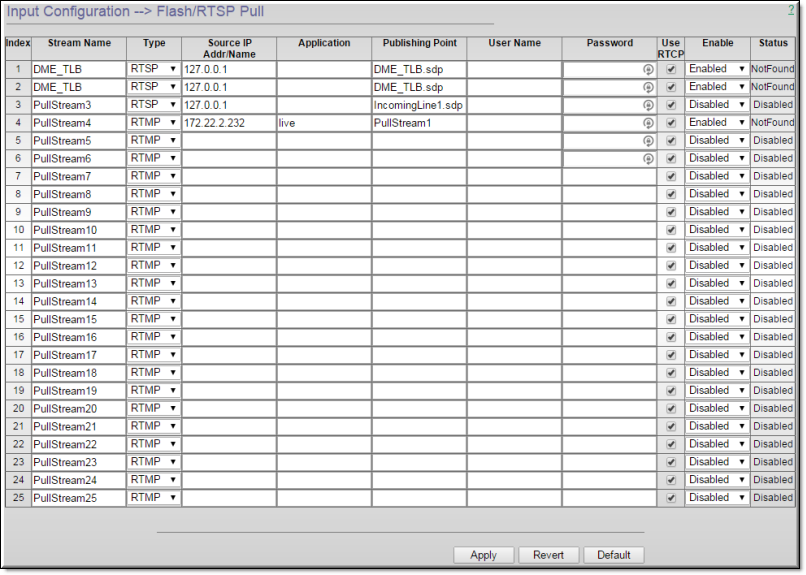In-6 < Pull (RTSP)
In this scenario the input originates from an RTSP/RTP external source. Examples are the server on an H.264 encoder another DME, a Wowza, QuickTime, or Darwin server.
The stream is pulled (via the RTSP session protocol) from the external source. The DME can pull from various outside sources (e.g. from another DME, or from a Wowza, QuickTime, or Darwin server). An RTSP Pull is configured in the DME on the > page.
The stream packets are received as RTP and used as a source for any of the output protocols. Another use of this protocol is to pull the live stream from the DME's RTP server and deliver it as a source for one of the Multi Protocol server’s output protocols or as a source for transrating.
Figure 1. Flash/RTSP Pull
Field | Description |
Type | |
Server:Port | The IP address and port number of the VBrick server. Enter a port number only if you are not using the default RTMP port (1935) or the default RTSP port (554). |
Application | Only required if you are pulling RTMP from an RTMP server such as another DME or an FMS. See In-5 < Pull (RTMP). This string is defined by the source. |
Publishing Point | This is the on the Program Configuration > Servers page on the encoder. |
Stream Name | User-friendly name displayed on the DME. Used, for example, to simplify cryptic publishing point names coming from a CDN. This name becomes the incoming stream name the DME uses to distribute the stream in multiple ways. |
User Name | If the incoming stream requires authentication, enter the user name and password. |
Password | If the incoming stream requires authentication, enter the user name and password. |
Use RTCP | Lets you use RTCP sync reports for the incoming stream. If you know your source does not produce RTCP reports, uncheck this box. |
Status | Displays the high-level status (Disabled | Connected | Receiving) of the incoming stream. |
 To configure a pull (RTSP) input:
To configure a pull (RTSP) input:Objective: Pull an RTSP unicast RTP stream(s) from a source as input to the DME. If the stream is coming from an external server, like a VBrick H264 encoder, follow steps 1 and 2, and 3. Otherwise the stream should be active and available either from another DME, or internally from the same DME, and you can start at Step 4.
1. In the encoder, set the desired Audio/Video configuration for frame rate, resolution, video and audio rate, sampling frequency etc.
2. In the encoder, select a stream to send, set the stream type to RTP, and select the streams you want to send to the DME (including audio, video, or both).
3. In the encoder, select the resource name of the stream to be used in the server component of the encoder. The default name for streams served from the encoder is vbStream1S1. You can change the name to anything you want. You also need to enable the server.
4. In the DME, launch the management interface, log in, and go to System Configuration > Flash/RTSP Pull Settings. You will need to pull an RTSP stream from a source, so find an open slot from the 25 possible slots and select RTSP as the type. Enter the server IP address or DNS host name, and enter the port if not already 554 (default port for RTSP). Since this is RTSP, no entry for Application is required. Enter the publishing point name like vbStream1S1. If you are pulling a stream specified in use case
In-8 < Unicast/Multicast RTP or
In-3 < RTP Auto Unicast, enter the sdp filename used when creating the stream. In most cases there will no need for the user name and password since this is a pull. Note: the pull uses RTSP Interleaved streams delivered by TCP only so make sure this is supported on the source.
5. If you know the RTSP source does not generate RTCP reports, or the RTCP reports do not have accurate time sync information, uncheck the Use RTCP box and the DME will not look for RTCP reports or ignore those coming in. Note: RTCP reports help to enable audio and video sync. If unchecked, there will be no way to "re-sync" the stream once it has started. Uncheck only if you have knowledge of the source and the RTCP reports it sends.
6. Enable the stream and apply, and the DME will start acquiring the stream. This stream can now be redistributed by the DME.

See Also:


